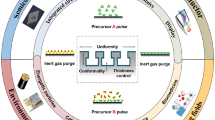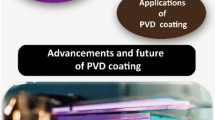Abstract
Oligomers of undecylurea (OUA11) thin films with a high crystallinity, surface hardness, perpendicular orientation, and low dielectric constant were fabricated by physical vapor deposition. The thin films were composed of single OUA11, which has a relatively high molecular weight (Mw: 2500, Mn: 1200) and could be vapor-deposited without thermal decomposition. These films had a much higher crystallinity and a high surface hardness level of 9H in the pencil hardness test. The dielectric constant of the OUA11 films is estimated to be 2.1–2.3 in the frequency range of 1 Hz–0.1 MHz, which is lower than that of typical low dielectric constant (low-k) materials. These physical and electrical properties are caused by the unique structure with the molecular dipoles-oriented parallel to the electrodes on the substrate and the strong intermolecular hydrogen bonds. The unique structure could not be observed with spin-coating and is specific to the vapor-deposited films. We expect that the OUA11 films with a high hardness and a low dielectric constant can be used not only as protective coatings but also as electronic materials.






Similar content being viewed by others
References
Askari F, Barikani M, Barmar M (2013) Study on thermal stability of polyurethane-urea based on polysiloxane and polycaprolactone diols. Korean J Chem Eng 30:2093–2099. https://doi.org/10.1007/s11814-013-0139-z
Castagna AM, Pangon A, Dillon GP, Runt J (2013) Effect of thermal history on the microstructure of a poly(tetramethylene oxide)-based polyurea. Macromolecules 46:6520–6527. https://doi.org/10.1021/ma400856w
Morimoto M, Koshiba Y, Misaki M, Ishida K (2015) Thermal stability of piezoelectric properties and infrared sensor performance of spin-coated polyurea thin films. Appl Phys Express 8:101501-1–101501-3. https://doi.org/10.7567/apex.8.101501
Mohotti D, Ngo T, Mendis P, Raman SN (2013) Polyurea coated composite aluminium plates subjected to high velocity projectile impact. Mater Des 52:1–16. https://doi.org/10.1016/j.matdes.2013.05.060
Grujicic M, He T, Pandurangan B, Svingala FR, Settles GS, Hargather MJ (2012) Experimental characterization and material-model development for microphase-segregated polyurea: an overview. J Mater Eng Perform 21:2–16. https://doi.org/10.1007/s11665-011-9875-6
Cai L, Al-Ostaz A, Li X, Fowler C, Cheng AH-D, Alkhateb H (2015) Protection of steel railcar tank containing liquid chlorine from high speed impact by using polyhedral oligomeric silsesquioxane-enhanced polyurea. Int J Implant Eng 75:1–10. https://doi.org/10.1016/j.ijimpeng.2014.06.015
Yanase T, Hasegawa T, Nagahama T, Shimada T (2012) Fabrication of piezoelectric polyurea films by alternating deposition. Jpn J Appl Phys 51:041603-1–041603-4
Morimoto M, Tsujiura Y, Koshiba Y, Kanno I, Ishida K (2017) Vibration energy harvester with piezoelectric properties using polyurea thin films. Mol Cryst Liq Cryst 653:188–193. https://doi.org/10.1080/15421406.2017.1351287
Tasaka S, Ohta H, Inagaki N (2000) Nonelectrical poling in ferroelectric polythioureas. IEEE Trans Ultrason Ferroelectr Freq Control 47:1316–1320. https://doi.org/10.1109/58.883520
Kubono A, Murai M, Tasaka S (2008) High piezoelectric activity in nonpoled thin films prepared by vapor deposition polymerization. Jpn J Appl Phys 47:5553–5557. https://doi.org/10.1143/JJAP.47.5553
Morimoto M, Koshiba Y, Misaki M, Ishida K (2015) Polyurea spin-coated thin films: pyro- and piezoelectric properties and application to infrared sensors. Jpn J Appl Phys 54:04DK13-1–04DK13-4. https://doi.org/10.7567/jjap.54.04dk13
Tasaka S, Shouko T, Inagaki N (1992) Ferroelectric polarization reversal in polyureas with odd number of CH2 groups. Jpn J Appl Phys 31:L1086–L1088. https://doi.org/10.1143/JJAP.31.L1086
Tajitsu Y, Ishida K, Kanbara S, Ohigashi H, Date M, Fukada E (1998) Temperature dependence of switching characteristics in polyurea-5 thin films. Jpn J Appl Phys 37:5375–5378. https://doi.org/10.1143/jjap.37.5375 (polyurea-5)
Hattori T, Takahashi Y, Iijima M, Fukada E (1996) Piezoelectric and ferroelectric properties of polyurea-5 thin films prepared by vapor deposition polymerization. J Appl Phys 79:1713–1721. https://doi.org/10.1063/1.360959 (polyurea-5)
Morimoto M, Koshiba Y, Misaki M, Ishida K (2015) Structural and electrical characterization of spin-coated polyurea thin films. Polymer (Guildf) 79:128–134
Chauhan KV, Sullivan P, Yang JL, Jones TS (2010) Efficient organic photovoltaic cells through structural modification of chloroaluminum phthalocyanine/fullerene heterojunctions. J Phys Chem C 114:3304–3308. https://doi.org/10.1021/jp910601k
Treier M, Richardson NV, Fasel R (2008) Fabrication of surface-supported low-dimensional polyimide networks. J Am Chem Soc 130:14054–14055. https://doi.org/10.1021/ja805342n
Kuwajima S, Horie S, Horiuchi T, Yamada H, Matsushige K, Ishida K (2009) Crystal and layer structures of ferroelectric oligomer thin films. Macromolecules 42:3353–3357. https://doi.org/10.1021/ma802639r
Ueda Y, Ashida M (1980) The structure of n-hexatriacontane film vacuum-deposited on alkali halide crystals and its transformation by heat treatment. J Electron Microsc 29:38–44. https://doi.org/10.1093/oxfordjournals.jmicro.a050206
Fukao K, Horiuchi T, Matsushige K (1989) Observation of molecular orientation in evaporated films of n-paraffins. Thin Solid Films 171:359–366. https://doi.org/10.1016/0040-6090(89)90642-1
Tanaka K, Okui N, Sakai T (1991) Molecular orientation behavior of paraffin thin films made by vapor deposition. Thin Solid Films 196:137–145. https://doi.org/10.1016/0040-6090(91)90181-V
Kubono A, Minagawa Y, Ito T (2009) In situ observation of layer-by-layer growth in vapor deposition of organic thin films. Jpn J Appl Phys 48:020211-1–020211-3. https://doi.org/10.1143/JJAP.48.020211
Noda K, Ishida K, Horiuchi T, Matsushige K, Kubono A (1999) Structures of vinylidene fluoride oligomer thin films on alkali halide substrate. J Appl Phys 86:3688–3693. https://doi.org/10.1063/1.371279
Nagamatsu S, Kaneto K, Azumi R, Matsumoto M, Yoshida Y, Yase K (2005) Correlation of the number of thiophene units with structural order and carrier mobility in unsubstituted even- and odd-numbered alpha-oligothiophene films. J Phys Chem B 109:9374–9378. https://doi.org/10.1021/jp044222l
Chisaka J, Lu M, Nagamatsu S, Chikamatsu M, Yoshida Y, Goto M, Azumi R et al (2007) Structure and electrical properties of unsubstituted oligothiophenes end-capped at the β-position. Chem Mater 19:2694–2701. https://doi.org/10.1021/cm0701658
Zhou Y, Taima T, Shibata Y, Miyadera T, Yamanari T, Yoshida Y (2011) Controlled growth of dibenzotetraphenylperiflanthene thin films by varying substrate temperature for photovoltaic applications. Sol Energy Mater Sol Cells 95:2861–2866. https://doi.org/10.1016/j.solmat.2011.06.001
Mitsuta H, Miyadera T, Ohashi N, Zhou Y, Taima T, Koganezawa T, Yoshida Y et al (2017) Epitaxial growth of C 60 on rubrene single crystals for a highly ordered organic donor/acceptor interface. Cryst Growth Des 17:4622–4627. https://doi.org/10.1021/acs.cgd.7b00467
Meurisch K, Gojdka B, Strunskus T, Zaporojtchenko V, Faupel F (2012) Vapour phase deposition of highly crystalline self-poled piezoelectric nylon-11. J Phys D Appl Phys 45:055304-1–055304-6. https://doi.org/10.1088/0022-3727/45/5/055304
Qian X, Song L, Yu B, Yang W, Wang B, Hu Y, Yuen RKK (2014) One-pot surface functionalization and reduction of graphene oxide with long-chain molecules: preparation and its enhancement on the thermal and mechanical properties of polyurea. Chem Eng J 236:233–241. https://doi.org/10.1016/j.cej.2013.09.061
Li X, Chen D (2008) Synthesis and characterization of aromatic/aliphatic co-polyureas. J Appl Polym Sci 109:897–902. https://doi.org/10.1002/app.24913
Liu S, Cui Z, Zhao Q, Fu P (2014) Piezoelectricity and ferroelectricity in odd-odd nylons with long alkane segments. Appl Phys Lett 104:172906-1–172906-4. https://doi.org/10.1063/1.4875017
Chonan Y, Matsuba G, Hioki J, Itoh T, Akizuki T (2013) Crystal structure analysis for polyurea. In: Proceedings of the 12th asian text, conference, pp 220–223
Zhang Q, Mo Z, Zhang H, Liu S, Cheng S (2001) Crystal transitions of nylon 11 under drawing and annealing. Polymer (Guildf) 42:5543–5547. https://doi.org/10.1016/S0032-3861(01)00050-7
Ohsawa Y, Takahashi R, Maruyama S, Matsumoto Y (2016) Direct synthesis of porous polyurea films by vapor deposition polymerization in ionic liquid. ACS Macro Lett 5:1009–1013. https://doi.org/10.1021/acsmacrolett.6b00594
Busca G, Ramis G, Lorenzelli V, Janin A, Lavalley J-C (1987) FT-ir study of molecular interactions of olefins with oxide surfaces. Spectrochim Acta A Mol Spectrosc 43:489–496. https://doi.org/10.1016/0584-8539(87)80049-1
Arnett RL, Crawford BL (1950) The vibrational frequencies of ethylene. J Chem Phys 18:118–126. https://doi.org/10.1063/1.1747428
Sanchez Escribano V, Busca G, Lorenzelli V (1990) Fourier transform infrared spectroscopic studies of the reactivity of vanadia-titania catalysts toward olefins. 1. Propylene. J Phys Chem 94:8939–8945. https://doi.org/10.1021/j100389a017
Coleman MM, Sobkowiak M, Pehlert GJ, Painter PC, Iqbal T (1997) Infrared temperature studies of a simple polyurea. Macromol Chem Phys 198:117–136. https://doi.org/10.1002/macp.1997.021980110
Luo N, Wang D-N, Ying S-K (1997) Hydrogen-bonding properties of segmented polyether poly (urethane urea) copolymer. Macromolecules 30:4405–4409. https://doi.org/10.1021/ma951386e
Gulmine JV, Janissek PR, Heise HM, Akcelrud L (2002) Polyethylene characterization by FTIR. Polym Test 21:557–563. https://doi.org/10.1016/S0142-9418(01)00124-6
Abe K, Sakurai H (2006) A trend of low dielectric constant materials. Kobunshi 55:82–85. https://doi.org/10.1295/kobunshi.55.82
Yokoyama D, Saito H, Kitai Y, Fujiwara H, Inagaki K (2012) Developing thermosetting resin system with low molecular weight PPE to achieve lower dielectric property. J Netw Polym (Japanese) 33:336–340. https://doi.org/10.11364/networkpolymer.33.336
Nguyen CV, Carter KR, Hawker CJ, Hedrick JL, Jaffe RL, Miller RD, Remenar JF et al (1999) Low-dielectric, nanoporous organosilicate films prepared via inorganic/organic polymer hybrid templates. Chem Mater 11:3080–3085. https://doi.org/10.1021/cm990114d
Volksen W, Miller RD, Dubois G (2010) Low dielectric constant materials. Chem Rev 110:56–110. https://doi.org/10.1021/cr9002819
Maier G (2001) Low dielectric constant polymers for microelectronics. Prog Polym Sci 26:3–65. https://doi.org/10.1016/S0079-6700(00)00043-5
Acknowledgements
The authors thank Unitika Ltd. for supplying OUA11 and PUA11. This work was partly supported by the MIKIYA Science and Technology Foundation and JSPS KAKENHI.
Author information
Authors and Affiliations
Corresponding author
Ethics declarations
Conflict of interest
The authors declared that they have no conflict of interest.
Electronic supplementary material
Below is the link to the electronic supplementary material.
10853_2018_3000_MOESM1_ESM.tif
See supplementary materials for FT-IR RAS and transmission spectra of spin-coated OUA11 films a in the urea bond vibration region and b in the alkyl chain vibration region (TIFF 669 kb)
Rights and permissions
About this article
Cite this article
Morimoto, M., Fukutomi, T., Koshiba, Y. et al. High hardness and low dielectric constant thin films with oriented urea oligomers by physical vapor deposition. J Mater Sci 54, 2483–2492 (2019). https://doi.org/10.1007/s10853-018-3000-2
Received:
Accepted:
Published:
Issue Date:
DOI: https://doi.org/10.1007/s10853-018-3000-2




